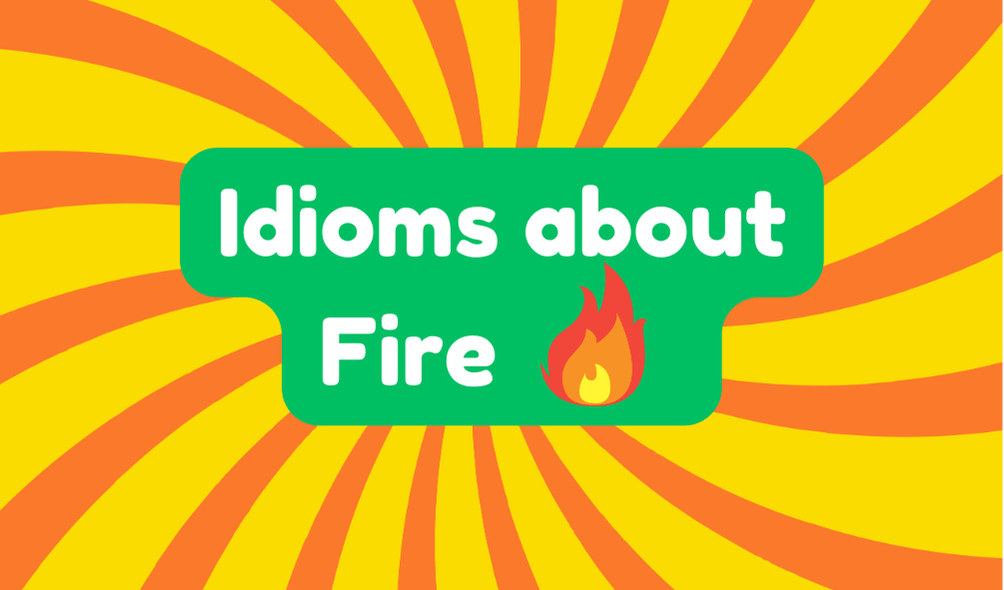Fire has captivated human imagination since prehistoric times. It warms our homes, cooks our food, and lights our way through darkness. Beyond its practical uses, fire has become deeply embedded in our language as a powerful metaphor for everything from passion and anger to destruction and transformation. This collection explores ten vivid idioms that harness fire’s symbolic power to express complex human experiences.
1. Playing with Fire
Short meaning: Engaging in risky behavior that could lead to trouble or harm.
Few elements command respect like fire. Its warmth can sustain life, but its fury can destroy everything in its path. The idiom “playing with fire” captures this duality perfectly—warning against actions that might seem harmless or exciting at first but could spiral into dangerous consequences.
When we tell someone they’re playing with fire, we’re cautioning them about potential danger ahead. Maybe it’s a friend considering an affair, a colleague cutting ethical corners at work, or a teenager experimenting with substances. The underlying message remains consistent: beware, because once flames get out of control, the damage can be irreversible.
The expression likely originated from literal observations. Children fascinated by flames might reach toward them, not understanding the painful burn that would result. Over time, this concrete warning expanded to encompass all situations where people flirt with danger without acknowledging potential consequences.
Consider Sarah, who starts skipping her university classes to pursue a sudden romantic interest. Her roommate might warn, “You’re playing with fire by neglecting your studies—one failed exam could jeopardize your scholarship.” The idiom communicates both concern and a forecast of possible trouble ahead.
What makes this expression endure is its visual clarity. We can easily imagine someone’s fingers dancing too close to flames, followed by the inevitable pain of being burned. The image provides an immediate, visceral warning that resonates across cultures and generations.
2. Spread Like Wildfire
Short meaning: To proliferate or disperse extremely rapidly.
In nature, few phenomena move as quickly as wildfire. Under the right conditions—dry vegetation, strong winds, low humidity—flames can race across landscapes at astonishing speeds, consuming everything in their path. The idiom “spread like wildfire” harnesses this dramatic visual to describe how information, trends, or ideas can propagate with similar explosive speed through communities.
Before the digital age, this expression might describe how gossip traveled through a small town, where news passed from person to person until everyone knew the latest scandal. Today, we’re more likely to use it when describing viral content online—a dramatic video might “spread like wildfire” across social media platforms, garnering millions of views in mere hours.
The idiom first appeared in written English during the 16th century, though the concept likely predates formal documentation. Shakespeare used a similar metaphor in “The Merchant of Venice” when he wrote about how “truth will come to light” like “fire in the night.”
What gives this expression its staying power is its accuracy. Information truly can proliferate at rates comparable to actual wildfires, especially in our interconnected world. When a celebrity makes a controversial statement during an interview, discussion can ignite instantaneously across continents. Political news, celebrity gossip, and heartwarming stories all move through our social networks with flame-like intensity.
The expression carries a certain inevitable quality—once information begins spreading like wildfire, attempting to contain it often proves futile. Just as firefighters can only hope to control a wildfire’s direction rather than extinguish it immediately, once a rumor or story gains momentum, it frequently burns through communities until it naturally exhausts itself.
3. Firing on All Cylinders
Short meaning: Operating at maximum efficiency or full capacity.
While not referencing literal flames, this idiom connects to fire’s energetic properties through the combustion that powers automobile engines. When someone or something is “firing on all cylinders,” they’re performing at peak capacity—every component working in perfect harmony to generate maximum power and efficiency.
The expression originated in early automotive culture. In an internal combustion engine, each cylinder contains a spark plug that ignites fuel to drive the piston. If all cylinders fire correctly, the engine runs smoothly and powerfully. Any misfiring cylinder results in reduced performance—making the complete “firing” of all cylinders the ideal state of operation.
We apply this idiom broadly to describe peak performance in various contexts. A basketball team might be “firing on all cylinders” during a game where every player contributes effectively. A restaurant could earn this description when kitchen staff, servers, and management coordinate seamlessly during a busy dinner service. A creative professional might use it to describe those rare, productive days when ideas flow effortlessly and obstacles disappear.
What makes this expression particularly useful is how it acknowledges the multiple components necessary for excellence. Success rarely comes from a single factor—rather, it emerges when numerous elements align perfectly. The idiom captures this truth while conveying the energetic quality of peak performance.
Consider how different the feeling is between sluggish, ordinary work days and those exceptional times when everything clicks. There’s an unmistakable energy—a fire-like quality—to those peak experiences. We feel more alive, more capable, more present. The idiom “firing on all cylinders” captures this state perfectly, tying together mechanical precision with the energetic qualities of fire.
4. Light a Fire Under Someone
Short meaning: To motivate or pressure someone to act with greater urgency.
When someone needs motivation to accelerate their efforts, we might say they need a “fire lit under them.” This vivid expression evokes the image of someone lounging comfortably until heat beneath them prompts immediate action. It suggests applying pressure to transform complacency into urgent activity.
The idiom likely evolved from literal observations of how quickly creatures (humans included) move when confronted with heat or flames. This basic survival response—moving quickly away from fire—translated into a metaphor for sparking action through external pressure or motivation.
Parents might use this approach with procrastinating teenagers, setting stricter deadlines or introducing consequences to “light a fire under them” regarding homework or chores. Managers employ this strategy when projects lag behind schedule, perhaps by establishing more frequent check-ins or emphasizing approaching deadlines to increase team urgency.
What distinguishes this expression is its implication of external motivation rather than internal drive. When we “light a fire under someone,” we’re typically applying pressure from outside—creating circumstances that make continued inaction uncomfortable. This differs from inspiring intrinsic motivation, though ideally, external pressure eventually sparks internal drive.
The idiom also captures an important truth about human nature: we often need external catalysts to overcome inertia. Many people perform best when facing moderate pressure—enough to energize and focus without overwhelming. Just as fire transforms substances through heat application, appropriate pressure can transform potential energy into productive action.
5. Fire in the Belly
Short meaning: Strong determination, ambition, or passionate drive to succeed.
Unlike external motivation, “fire in the belly” describes internal drive—an intense, burning ambition that propels someone forward despite obstacles. This idiom locates passion in our core, suggesting determination that emanates from deep within rather than being imposed from outside.
The expression likely emerged from ancient understandings of the body, where the stomach region was considered the seat of courage and passion. Many cultures associated this area with vital energy—Chinese medicine speaks of “fire chi” in the abdomen, while Western traditions sometimes described courage as “gut feeling” or “intestinal fortitude.”
We use this idiom to describe individuals who demonstrate remarkable persistence and drive. The young entrepreneur working around the clock to launch her business has “fire in her belly.” The activist dedicating decades to a cause displays this quality. Athletes pushing through exhaustion to reach new performance levels exemplify this internal flame.
What makes this expression powerful is how it communicates both intensity and sustainability. External motivation might spark immediate action, but internal fire sustains effort over time. Someone with genuine fire in the belly continues pushing forward long after others have abandoned similar pursuits.
This quality often differentiates extraordinary achievers from average performers. While talent, opportunity, and privilege certainly influence outcomes, this internal fire frequently determines who perseveres through inevitable setbacks. It’s the difference between someone who views obstacles as temporary challenges versus insurmountable barriers.
Consider historical figures like Marie Curie, who pursued scientific discovery despite tremendous barriers to women in science, or Nelson Mandela, whose determination remained unquenched through decades of imprisonment. These individuals exemplify the transformative power of having fire in the belly—an internal flame that illuminates purpose even during the darkest times.
6. Baptism by Fire
Short meaning: A difficult introduction to a new situation or role through immediate immersion.
Some learning experiences come gradually, with careful instruction preceding responsibility. Others throw us directly into challenging situations, forcing rapid adaptation. The latter approach is often called a “baptism by fire”—an intense, immersive introduction that tests capabilities immediately rather than incrementally.
The expression has religious origins, referencing biblical passages about spiritual baptism “with the Holy Spirit and fire.” Over time, it evolved beyond religious contexts to describe any challenging initiation experience. Military usage popularized the idiom, where new soldiers facing immediate combat were said to receive their “baptism by fire.”
Today, we apply this expression broadly to difficult beginnings across various fields. A new teacher assigned to the school’s most challenging class experiences a baptism by fire. A medical resident handling her first emergency room shift alone undergoes this trial. A newly promoted manager navigating an immediate company crisis faces such an initiation.
What distinguishes these situations is their immersive nature. Rather than gradual introduction through observation or simulation, baptism by fire places individuals directly into challenging circumstances. While stressful, this approach often accelerates learning and reveals capabilities that might remain dormant under gentler conditions.
Many professionals recall their baptism by fire as transformative, despite its difficulty. The restaurant manager who handled her first Saturday night when half the staff called in sick. The lawyer who unexpectedly had to take over a court appearance on short notice. The parent bringing home twins without any previous childcare experience. These intense introductions often produce not just competence but confidence—a proven knowledge that one can handle difficult situations when necessary.
The baptism by fire approach contradicts our careful, incremental educational methods, yet sometimes necessity demands immediate immersion. The resulting growth, while challenging, often produces resilience and adaptability that more comfortable introductions might not develop.
7. Out of the Frying Pan, Into the Fire
Short meaning: Moving from a bad situation directly into an even worse predicament.
Sometimes attempts to escape difficulty lead only to greater trouble. The idiom “out of the frying pan, into the fire” captures this predicament perfectly—describing the frustrating experience of fleeing one problem only to encounter a more serious one.
This expression has ancient roots, appearing in similar forms across multiple cultures and languages. Roman writer Quintus Ennius used a comparable phrase in the 2nd century BCE. The idiom entered English literature through John Heywood’s 1546 collection of proverbs, demonstrating its enduring relevance to human experience.
We encounter this situation in countless scenarios. The employee who leaves a difficult job only to find their new workplace even more toxic has jumped from the frying pan into the fire. The student who drops a challenging professor’s class only to find the replacement instructor even more demanding experiences this frustration. The person who ends one problematic relationship only to immediately begin another with more serious issues knows this pattern all too well.
What makes this idiom particularly resonant is how it acknowledges the natural human tendency to seek immediate relief from discomfort, sometimes at the expense of long-term wellbeing. The frying pan, while uncomfortable, represents a manageable problem—hot enough to motivate escape but not immediately destructive. The fire represents a far more serious threat, potentially causing irreparable harm.
The expression serves as a caution against hasty decisions driven by discomfort rather than careful consideration. It reminds us that immediate relief doesn’t always lead to improvement and that sometimes enduring temporary difficulties prevents worse outcomes later. This wisdom appears across cultural traditions, from Aesop’s fables to Buddhist teachings about impulsive reactions creating greater suffering.
In modern contexts, the idiom often describes how quick fixes for complex problems can create more severe issues. The nation that addresses social unrest with harsh crackdowns rather than addressing underlying grievances. The company that cuts quality control to meet deadlines, leading to costly recalls. The individual who treats symptom after symptom without addressing root causes. All exemplify movement from frying pan to fire.
8. Keep the Home Fires Burning
Short meaning: To maintain a sense of normalcy, comfort, and continuity during difficult times.
During prolonged separation or challenging periods, maintaining connection to home becomes crucial. The idiom “keep the home fires burning” captures this concept—referring to sustaining the warmth, comfort, and continuity of home life despite external challenges.
The expression gained popularity during World War I through a patriotic British song encouraging those on the home front to maintain household normalcy while awaiting soldiers’ return. The literal hearth fire represented both physical warmth and the emotional center of family life—something worth preserving despite separation and uncertainty.
Today, we use this idiom more broadly to describe maintaining stability during various challenges. Military families still “keep the home fires burning” during deployments by preserving traditions and routines. Couples in long-distance relationships sustain their connection through regular communication. Families facing medical crises or financial hardships make efforts to maintain some sense of normalcy despite difficult circumstances.
What gives this expression its emotional resonance is how it acknowledges both absence and continuity simultaneously. The “home fires” require tending in part because someone is missing or because circumstances have changed. Yet the act of maintenance itself becomes an affirmation—a declaration that what matters most will be preserved despite current challenges.
The idiom connects to deeper human needs for stability and belonging. Throughout history, the hearth represented not just physical survival but cultural continuity—the place where stories were shared, meals prepared, and community maintained. By invoking this image, the expression taps into our fundamental desire for connection and continuity, particularly when these qualities seem threatened.
In contemporary society, “keeping the home fires burning” might involve maintaining family dinner traditions despite busy schedules, continuing holiday celebrations during financial constraints, or preserving meaningful routines during illness. These acts affirm that while circumstances change, core values and connections endure.
9. Where There’s Smoke, There’s Fire
Short meaning: Signs of trouble usually indicate a real problem exists.
Human experience teaches us that warning signs typically connect to underlying issues. The idiom “where there’s smoke, there’s fire” captures this wisdom—suggesting that visible indicators (smoke) usually point to actual problems (fire), even when the full extent remains temporarily hidden.
This expression draws from simple observation of fire’s natural properties. Smoke rarely appears without accompanying flame—even when that flame remains concealed from immediate view. Similarly, rumors, concerns, or troubling patterns rarely emerge without some factual basis, though determining the precise nature of the underlying truth requires investigation.
We apply this idiom when patterns suggest problems worth investigating. Repeated customer complaints about product quality might prompt a manager to think, “where there’s smoke, there’s fire,” initiating deeper examination of manufacturing processes. Persistent rumors about impropriety within an organization could trigger this same realization, leading to formal inquiry. A parent noticing sudden behavioral changes in their teenager might invoke this wisdom, recognizing that visible signs likely connect to underlying issues.
What makes this expression valuable is its balance between suspicion and confirmation. It acknowledges that initial indicators deserve serious consideration while recognizing that further investigation remains necessary. The idiom neither dismisses concerns as meaningless nor accepts them as definitively proven—instead, it recommends appropriate attention to warning signs.
This balanced approach proves particularly useful in complex situations where initial evidence appears ambiguous. The smoke metaphor acknowledges that early warnings may seem hazy or difficult to interpret precisely, yet still merit attention. Just as a forest ranger would investigate distant smoke rather than dismissing it, wisdom suggests examining troubling patterns even when their full significance remains unclear.
The expression also reminds us that problems typically produce multiple indicators before becoming obvious catastrophes. Just as actual fires generate smoke before flames become visible, interpersonal conflicts, organizational dysfunction, and personal difficulties often produce subtle warnings before developing into crises. Recognizing these early signals—the “smoke”—allows intervention before situations deteriorate further.
10. Go Down in Flames
Short meaning: To fail dramatically or spectacularly.
Not all endeavors succeed. Some attempts end not just in failure but in spectacular, memorable collapse. The idiom “go down in flames” captures these dramatic endings—describing failures so complete or visible that they resemble aircraft crashing and burning rather than simply falling short of goals.
The expression originated in military aviation, where aircraft literally “went down in flames” when shot down during combat. This vivid, tragic image later expanded to describe any dramatic failure, particularly those visible to observers. Unlike quiet disappointments, going down in flames implies a public dimension to the collapse.
We use this idiom for various spectacular failures. A political campaign might “go down in flames” after a candidate’s dramatic scandal emerges. A business presentation could earn this description after technical failures and poor preparation become evident. A relationship might “go down in flames” through public arguments and dramatic endings rather than quiet drifting apart.
What distinguishes this expression is its emphasis on the memorable, visible nature of the failure. When something goes down in flames, witnesses remember the collapse—it becomes a cautionary tale or notable event rather than a minor setback. The fiery image captures both the completeness of the failure and its attention-grabbing nature.
Despite its negative connotation, the idiom contains a certain grudging respect for the scale of the failure. Going down in flames implies commitment and visibility—the person or project was significant enough that its failure registered meaningfully. As the saying goes, “If you’re going to fail, fail spectacularly.” There’s something almost admirable about efforts substantial enough to produce memorable collapse rather than forgettable mediocrity.
The expression also captures how certain failures seem to accelerate and intensify as they unfold. Just as a falling aircraft might initially appear recoverable before erupting into flames, some endeavors begin with minor problems that cascade into spectacular disasters. The businessperson whose small ethical compromise leads to increasingly serious deceptions until public exposure destroys their career. The production whose minor technical issues multiply until opening night becomes a legendary disaster. These accelerating failures embody the dramatic quality of going down in flames.
Fire’s Enduring Power in Language
These ten idioms demonstrate fire’s remarkable versatility as a linguistic metaphor. From motivational “fire in the belly” to cautionary “playing with fire,” flame-based expressions capture countless human experiences. This versatility stems from fire’s fundamental duality—its capacity to both create and destroy, to comfort and terrify, to illuminate and consume.
Fire’s presence in our language reflects its essential role in human development. As one of the earliest technologies mastered by our ancestors, fire has shaped human experience for thousands of generations. It provided warmth in hostile environments, transformed inedible substances into nourishment, and extended daylight into darkness. Our relationship with fire was so fundamental that it inevitably became encoded in our communication systems.
The idioms explored here represent just a fraction of fire-related expressions across languages and cultures. From “trial by fire” to “slow burn,” from “firing squad” to “eternal flame,” our languages overflow with fiery references. Each captures some aspect of our complex relationship with this elemental force—acknowledging both its constructive potential and its destructive power.
Fire imagery resonates across cultural boundaries precisely because its physical properties transcend linguistic differences. Whether in Ancient China, medieval Europe, or contemporary global society, humans recognize fire’s capacity to transform, its hunger for fuel, its tendency to spread, and its visible warning signs. These universal qualities make fire-based idioms immediately comprehensible across diverse contexts.
As we navigate contemporary challenges, these ancient expressions continue offering wisdom. They remind us to respect potential consequences (playing with fire), recognize warning signs (where there’s smoke, there’s fire), maintain stability during difficulty (keep the home fires burning), and acknowledge both the constructive and destructive potential of powerful forces in our lives.
Fire—in all its complexity—continues illuminating our understanding of human experience, burning brightly through our language as it has through countless generations before us.






